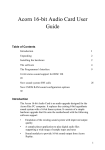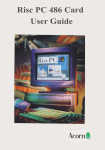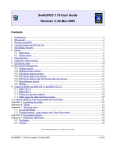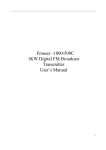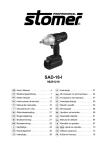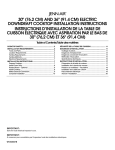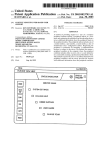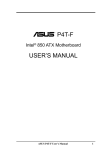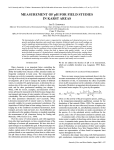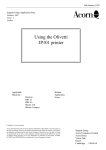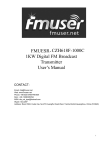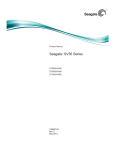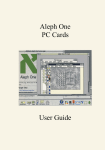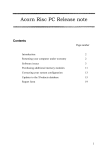Download Developers` Newsletter No. 33 April 1994
Transcript
Developers' Newsletter No 33 - April 1994 Contents: Acorn launches the Risc PC The Risc PC processor architecture Key Benefits of Risc PC Dual processor facility offers full 486 PC capability DMA Extended Bus Interface (DEBI) Acorn and multimedia Networking Full 24~bit colour Optional CD-ROM drive New, versatile case design Monitors Initial Product Configurations General News Non-Disclosure Agreements, NewDesk and NewLook Risc PC prices for Registered Developers Phased payment option Risc PC without a monitor PC card offer with Risc PC Availability of Risc PC Adding SIMMs Registered Developer Agreement Software Evaluation Agreements Registered Developer Handbooks Hardware Developers' meeting Errata and clarification Technical News C compiler Risc PC and the Developer Pointers for the future Memory management Expansion Cards Small memory machines Application Notes Writing FIQ code for the Risc PC Writing Games for RISC OS Risc PC Technical Reference Manual Risc PC Programmer's Reference Manual News from outside Acorn Emerald Publishing - Technical Documentation on CD-ROM Enclosures Registered Developers' Risc PC Discount Price List - April 1994 Registered Developers' Risc PC Discount Order Form Standing Order Mandate Risc PC Special Offers for Registered Developers ~ Order form and Agreement Risc PC launch pack (for Developers who did not attend the launch itself) Draft Acorn good practice guidelines for Developers User News, Issue 4 Acorn UK Retail Price List - April 1994 Acorn launches the Risc PC system, tried and tested by millions of users. A wealth of powerful applications software from personal productivity tools to true multimedia. True 24bit colour delivering 16 million colours. Low cost access to DOS and Windows applications Lightning fast manipulation of still and moving images. High-performance multi-channel stereo sound as standard on all models. Modular and upgradeable computer systems that grow with users' needs It was good to see so many of you on Friday April 15th at The Production Box at the Cumberland Hotel in London. We are sorry that some of you could not come and, for those people, we enclose packs of information about Risc PC. Now you know, precisely, the reason for the 'new archtitecture' meetings for Developers and the calls to you to come to Acorn House to test your products. Acorn is keen to ensure that Registered Developers are given every opportunity to prepare themselves for the introduction of new products in the market and to exploit the openings these bring. As one of the press releases said, "Acorn's marketing campaign is built around the theme 'A world of opportunities' which serves to highlight the wealth of opportunities that the new range will offer for users, and also for Acorn and its developer community." The Risc PC processor architecture Like its predecessor the ARM 3, the ARM610 is designed by Advanced RISC Machines (ARM) Limited and is a 32-bit RISC CPU with a 4 KB cache. The new processor gives the Acorn Risc PC exceptional performance, particularly in full-colour modes (when fitted with VRAM). For example, it is approximately twice as fast as the Acorn A5000 in 16 colour VGA mode. We are delighted that so many of you were able to test your products and to ensure that customers who wish to move to the Risc PC from earlier Acorn machines can do so confident in the knowledge that there are familiar products to run on it. To quote Sam Wauchope, Acorn's Managing Director, "The launeh of the Rise PC with such a huge number of software titles available to run on it will greatly benefit users. Risc PC's phenomenal capabilities will also offer software developers an elegant and supportive development platform, paving the way for a whole new generation of multimedia software development." Again, from the press release, 'Every Risc PC will be shipped with an application called !Products, a database giving users information about running existing RISC OS applications on the Risc PC. Information is included on approximately 850 current applications detailing whether they will run without amendments, if any minor configuration changes are needed or an upgrade is required. In the very few cases where an upgrade is required, details are provided of how to obtain this.' If you would like a copy of !Products, please contact Developer Support. We will be happy to provide one. Future upgradeability is guaranteed as faster versions of the ARM 600 and future generations of the ARM700 (Q4 1994) and ARM800 will be available for use in the Acorn R1SC family for seamless migration. Risc PC can address up to 256MB of memory and, although current technology limits its physical memory to 128MB using commercially available DRAM, the Risc PC has more than enough RAM to load and manipulate the largest full-colour images and combine them with text, graphics, video and sound. Risc PC also supports up to 2MB of VRAM. Dual processor facility offers full 486 PC capability The Risc PC's open architecture makes it possible to fit a second processor to the computer, sharing all the memory, input and output facilities of the main ARM610 processor. This represents a tremendous cost advantage over traditional processors mounted on an expansion card, which often required memory to be duplicated. Any processor may be used, provided its card contains all necessary arbitration logic. If you have an update to the information provided in !Products, please forward it to Developer Support (in Edit file(s) on a clearly marked disc) so that it can be used in any future issues which may be provided to Dealers, AiECs and new Risc PC owners. The first of these second processors to be offered on the Risc PC will be a 25/33 Mhz 486SX PC card including DOS. With a PC Card fitted and Windows added, the Risc PC will behave just like an ordinary 486 PC with Windows and a graphics accelerator offering SVGA video (800 x 600 x 16 million colours). The launch and Risc PC itself appear to have received/ generated almost universal acclaim. This is good news for us all and I am sure you will make good use of the opportunities presented. A special Application Specific IC (ASIC) is currently being developed embodying all the speed dependent PC logic. Performance will be further enhanced by an optional 32KB or 128KB secondary cache on the processor chip, which will be managed by a cache controller included in the ASIC. In addition to the pack, you may find useful the following brief technical overview of Risc PC: Key Benefits of Risc PC The world's most cost-effective, efficient 32-bit RISC computers. Low cost processor upgrade strategy, protecting the user's investment today and into the futur e. RISC OS - a It is expected that even higher performance PC cards, using the Pentium class processors, will be introduced in the future. Other uses of the dual processor capability are also being planned by independent developers. powerful, muli-tasking operating DMA Extended Bus Interface (DEBI) The Risc PC can take two single-width expansion cards in its standard configuration, plus two more for every centre- 1 section added to the system. The DEBI bus also supports Direct Memory Access (DMA), so data can be read from and written to system RAM by expansion cards, without interrupting the CPU. card) DOS CD-ROMs can be used. Acorn Replay movies can be played from CD-ROM, and (subject to copyright) images copied from both RISC OS and DOS format disc, translated into sprites, edited and used in RISC OS applications. The new DEBI bus makes it possible to implement even higher performance expansion cards handling large amounts of data, such as video-capture and direct-drive printer cards, which can have substantial on-card buffer memory, directly addressable to the ARM processor. The optional CD-ROM drive enables the user to read Kodak Photo CD-format discs, while the video performance of the Rise PC ensures that a high-quality picture is produced. Once displayed on the computer, PhotoCD images can be edited and dropped into multimedia publications. Acorn and multimedia New, versatile case design Acorn has consistently been a pioneer in the development of multimedia, from the earliest days of the BBC Micro, with sound, colour and graphics, to the latest innovations in full motion video and in the natural integration of CD-ROM technology with computers. As described above, every Risc PC comes with full 24-bit colour capability; the support for up to 256MB RAM and 2MB of VRAM; and a large hard disc ( minimum of 210MB). Stereo sound and video playback are also standard. An integral CD-ROM drive providing Photo CD support is also available as an added option. This all makes the new Risc PC the ideal choice for multimedia applications. • The Rise PC has eight channels of stereo sound as standard and has a built-in speaker and stereo headphones socket. This is complemented by Acorn Replay - Acorn's full motion video system. A world leader, Acorn Replay has made it possible for thousands of users to put together multimedia publications on Acorn computers at low cost. Acorn Replay's playback software, ARPlayer, is included with every Risc PC, together with a number of movies demonstrating the capabilities of Acorn Replay. The Acorn Risc PC range features an innovative case design. Leading design house Cambridge Product Design has combined contemporary styling and ergonomics to produce a product that is both aesthetically pleasing and practical. Constructed in a high-impact-resistant plastic, which is usually used in the manufacture of visors and riot shields, the case is robust and hard wearing. To cut down electrical emissions, the inside has been metal sprayed. The case's modular construction makes upgrading simple as the Risc PC can be taken apart in seconds without any tools. The Risc PC supports an almost limitless range of configurations and upgrades (memory, disc drives, CD - drives, expansion cards, network cards and even additional processors) and therefore this ease of access is important. The base system contains a 3.5" floppy disc drive, a hard disc ( at least 210 MB), one vacant bay for a 5.25" device (eg CDROM), two available expansion slots and a space for a networking card. Each additional system layer, or 'slice', enables the user to add an additional 3.5" device, a 5.25" device and two more expansion cards. Up to six additional slices can be added in total (the maximum number of expansion cards per system is eight). Adding extra devices or cards is achieved very simply. Cards are slotted directly into the back of the computer, network cards and additional 3.5" or 5.25" devices involve simply removing the lid and plugging in. Acorn's heritage in multimedia means a strong base of multimedia authoring applications already exist. These enable the user to combine video, audio, text and images in hypertext-linked documents which can be designed for interactive training, reference and project work. Networking Monitors The preferred means of networking is Ethernet and Acorn and/or third party suppliers support thick, thin and 10BASE-T media. Additional multi-session cards will enable one or more protocol stacks (e.g. TCP/IP and IPX) to be run simultaneously regardless of the type of media. The use of industry standards enables Acorn users to run mixed network environments with different types of machines where they are running standard software. The AKF60 Super VGA 14" monitor is included as standard with all initial Risc PC confirgurations. As an option, users of any of the Risc PC models can upgrade to an AKF85 17" monitor. The AKF85 will provide a high quality alternative monitor for users needing up to 1600 x 1200 resolution. Initial Product Configurations Full 24-bit colour System Configuration RRP exc VAT 1600 x 1200 resolution. Industry standard TIFF and JPEG 24-bit colour images can be loaded into the Risc PC, decompressed on the fly and displayed as RISC OS bit image files. Acorn Risc PC 600 2MB DRAM £1249 210MB hard disc Made possible by a new ARM VIDC20 video chip, a new colour picker or palette allows the user to work in one of the three colour modes - ROB, CMYK and HSV. Acorn Rise PC 600 4MB DRAM £1399 1MB VRAM 210MB hard disc Acorn Risc PC 600 8MB DRAM 1MB VRAM The Risc PC offers a choice of up to 16 million colours and up to Optional CD-ROM drive The Risc PC has an empty 5.25 inch drive bay, ready to receive an optional CD-ROM, providing an integrated, neat CD-ROM solution. Both RISC OS and (using a PC 420MB hard disc 2 1699 General News Risc PC without a monitor Non-Disclosure Agreements, NewDesk and NewLook It is recognised that some Registered Developers my wish to purchase a Risc PC without a monitor. If you wish to do so, please contact Developer Support, in writing, for a price. We would prefer, when you are demonstrating your products on Risc PC to the public, that you make every effort to use one of the standard Acorn monitors. Most of you will have realised that the launch of Risc PC releases you from the Non-Disclosure Agreement relating to 'future platform Architecture based upon ARM 6 and ARM 7 series processors' many of you entered into with Acorn. PC card offer with Risc PC Under the terms of the Agreement, those of you who signed the NDA, received from us a disc with the NewDesk software on it. Please be aware that Acorn does not support NewDesk on machines other than Risc PC and you should neither distribute it, nor use it publicly. NewDesk can be easily distinguished from the released 3D desktop software for RISC OS 3.1 (NewLook); NewDesk supports proportional fonts in title bars etc. Early purchasers of Risc PC will be able to purchase the PC card at the special price of £99 exc VAT when the card is available later in the year. If you wish to take adavantage of this offer, please make it clear to us at the time of ordering the Risc PC but do not include payment for the card at this time. We will then let you know nearer the time the procedure for obtaining the card. Availability of Risc PC To summarise, NewLook CAN be distributed freely, NewDesk CANNOT. We feel it is important that our customers are kept informed of the supply situation. Mike O'Riordan, our Sales and Marketing Director, informs me that, by the end of April, it is planned to supply dealers and AECs who order them with demonstration machines to show customers. Risc PC prices for Registered Developers Enclosed with this newsletter is a fixed-term special offer for Registered Developers and the Developers' Discount Price List for Risc PC. Note that Developers may purchase ONE machine only at the Special Offer Price and that the Offer is open to Developers until 31st July 1994. All orders under the Special Offer scheme must be entered on the Special Offer order form enclosed, must be separate from other orders and must also be accompanied by a Purchase Agreement signed by an authorised signatory of the Developer. Any additional Risc PCs and related materials should be ordered from the Developers' Discount Price List. We have introduced an order form for your use when ordering items. A copy is enclosed. Please, if you are about to make an order, copy the form first for future use! Despite good initial production levels, introductory sales are ahead of availability. We will attempt to allocate product on a fair basis while orders exceed supply. Developers' orders will receive careful consideration in this period but no specific promises can be made. Adding SIMMs Developers purchasing a Risc PC may wish to increase the available DRAM by adding larger SIMMs. Acorn does not stock these RAM modules, but they are available within the IT industry in addition to any Acorn Dealers and suppliers who may choose to stock them. Although Risc PC has been designed to use industry standard 72 pin SIMMs, there are some parameters that need to be specified to ensure that the SIMM works reliably in all conditions. In general, a modern 'x 32' SIMM designed for use in an Apple Mac Quadra at 70nS speed or better should work fine. PC clone 72 pin devices in 'x 36' format should also work if 70nS, but the 9th bit will not be used and may add to SIMM cost. Modern RAM chips should be used on the SIMM to keep chip count, and hence bus loading, down. These later SIMMs are sometimes referred to as 'non-composite'. Also, square row/address format RAM chips should be used. Please ask Developer Support for a SIMM information sheet if needed. Do not assume that 'any old' 72 pin S1MM from a PC supplier will be suitable; it may only marginally work. The same warning is valid for both PC clones and Apple Macs i.e. not all devices will work in all machines. Be prepared to specify what you require and, if you need guidance on particular suppliers, please contact Developer Support. Please note that all Developers' purchases of Risc PC computers are accompanied by 3-year on-site service/ extended warranty. When you purchase your Risc PC, you will (soon afterwards) receive a letter from us and subsequently, direct from our service agent, a communication detailing the support scheme. This is different from the TSA extended warranty product for earlier computer products which is shipped to you from our warehouse, as a card, with your computer. Phased payment option Acorn is pleased to offer to Developers the opportunity of purchasing Risc PC by phased payments via bank standing order. If you wish to take advantage of this facility, please divide the desired system price by twelve and complete the enclosed Standing Order Mandate adding any remaining pence to the first payment. Please do not add other items for payment by Standing Order. The option is only available for the purchase of a computer system and only one Standing Order per Registered Developer may be in progress at any one time. The phased payment option is only available on standard Developer Discount prices. Payment for Special Offer purchases must be made in full at the time of ordering. Registered Developer Agreement Several Developers have asked about the Acorn good practice guidelines. A draft has been drawn up and a copy 3 is enclosed. If you have comments, please write to us detailing your input before Friday 6 May so that we can consider it before preparing the final document. over the next few months, give a folder to any of you we happen to see so, if you are to be visiting someone at Acorn House, do let us know. We'll then give you your Handbook/ring binder. Software Evaluation Agreements Many Developers request items (source code and CFront, for instance) which are supplied to them under the terms of a Software Evaluation Agreement. Developers are required to sign and return the Agreement before the code is supplied. The code itself is sent to the Developer with the countersigned Agreement. Hardware Developers' meeting We hope to hold a meeting for Hardware Developers in May. It's likely to be in the Cambridge area. If you develop hardware and think we may not be aware that uou do, please contact us and we will send you an invitation when details are finalised. Developers should note that the Agreement is for a fixed term and the steps to be taken on termination are clear in the Agreement. Developers who do not comply with the terms of the Agreement they have entered into may be refused further items. Errata and clarification Please note that Data Sheet 8 from your Risc PC pack is inaccurate in one respect. The PC Card (when supplied as part of a Risc PC system) is supplied with DOS but n0t with Windows. Registered Developer Handbooks You may have wondered why we have recently sent your newsletters on punched paper. We have a special ring binder for each of you so that it will be easier for you to keep newsletters, discs, Developer prices lists, specifications etc. together and ready to hand. We will, Also in the pack are various references to 'slices' and expansion cards. To clarify, Acorn will only supply one and two slice configurations and an upgrade to take a one slice machine to two slices. We are also enabling a few third parties to offer further upgrades - possibly to six slices! Note that there is a maximum of 8 expansion slots. Technical News for an enhanced colour capability. Applications can take advantage of screen modes offering 1,2,4,8,16 or 32 bits per pixel with colours chosen from up to 16 million colours. In the new 16 bpp modes, 5 bits are allocated for Red, Green and Blue and in the 32 bpp modes, 8 bits each are allocated. ColourTrans operations have been extended to cater for best matching between applications colours and the actual screen palette in use. The VIDC20 palette now includes supremacy bit information as part of the 32 bit word which enables support for transparency and overlay colours. Screen resolutions can range up to 1280 x 1024 (1600 x 1200 is possible under certain circumstances) without the addition of further graphics cards. To support this greatly enhanced colour capability, a new Sprite format has been introduced for bit-mapped graphics and SW1 calls extended to support the wider range of screen displays. A new Colour Picker is supported by RISC OS which allows applications to provide flexible desktop dialogue boxes with which the user can manipulate colours in RGB, CMYK and HSV colour models. To enable applications using higher resolution graphics and colour depths to remain very fast in performance, Risc PC machines can be fitted with VRAM. VIDC20's 64 bit bus can take full advantage of any VRAM fitted and there are new operating system SWI calls in RISC OS to allow the programmer access to control the optimum use of the fitted DRAM/VRAM. C compiler The Risc PC literature refers to a Release 5 of the C Compiler. We had hoped to have made this available to Developers prior to the launch but licensing arrangements prevented us. This should be resolved shortly and we will send Release 5 to all Developers who have purchased the Registered Developer only Desktop C Issue 2 beta which was made available, on request, at £12 exc VAT, to all Developers who have Desktop C. If you would like a copy of the new compiler but do not have the beta, please send the enclosed order form with your cheque for £14.10 to Developer Support. We will provide both Compiler and the Desktop C Issue 2 beta which includes updates to the DDE utilities. Please note that you need to have Desktop C in order to use the new compiler. Release 5 comprises the compiler, linker and stubs only. In addition, on the Release 5 disc, we will supply a new version of DDT. The fact that Risc PC computers can be fitted with up to 256 MB of DRAM in addition to 2 MB of VRAM has resulted in extensions to the API for memory control by applications. The opportunity has also been taken to improve the RISC OS memory model which, together with the smaller memory page size of 4 KB, has allowed for more efficient use of any memory fitted to the computer. Dynamic areas of memory can now be created and removed in addition to being re-sized in an efficient way, allowing programs to share memory between applications Risc PC and the Developer There are many aspects of the Risc PC design that enable both software and hardware developers to deliver highperformance applications for a wide variety of markets. The enhanced hardware architecture has enabled R1SC OS to be extended in various areas providing a broader API for the programmer. The specification and performance of many of the hardware interfaces has been extended and, in particular, this includes the expansion card interface. The use of the new Video Controller, VIDC20, provides 4 and IRQ services. Fragmentation effects are reduced and new operating system calls allow applications to know much more about available memory. To complement this fast, extended memory architecture, DMA is now available to two of the expansion card positions. As well as the provision of DMA capability on two of the expansion card connectors, the expansion bus now has 32 bit capability in addition to the previous 8 and 16 bit modes. Cards also now have access to up to 16 MB of their own memory space. Higher performance I/O cards can be designed allowing data transfers of around 5 MB/sec or more; advantage can now be taken, for example, of the higher speed capabilities of the SCSI-2 specification. Developers should note that double-width expansion cards are no longer supported and single-width cards must meet the more stringent Eurocard width of 100mm. In line with the evermore demanding needs of users for faster peripheral device support, both the Parallel and Serial ports provide much faster data rates, under the control of the programmer, when required. A new buffer manager has been added to RISC OS and the Parallel port takes advantage of this. The buffer manager allows applications that require low latency to bypass the usual SWI call interface by making one initial call to set-up memory pointers. These pointers address control routines that manage data transfer to and from the parallel device through software buffers, minimising interrupt demands on the main processor and allowing many recently introduced fast-parallel devices to be supported. The Serial port now incorporates hardware buffers which allow baud rates up to 115 KB/sec, again minimising interrupt demands on the main ARM processor. A new SWI call has been included which enables applications to determine what types of I/O system chips are fitted, allowing applications to make optimum use of the platform on which the application is running. Hardware expansion capabilites are not limited to the area of I/O. A second-processor socket is provided on the main PCB which allows an alternative processor to be added to the computer. This processor has full access to the 32 bit bus and memory areas, but will need to include its own bus arbitration logic. many areas which are under the control of the application programmer, and perhaps we can list just a few here: Memory management Attached you will find a summary sheet of the key points to take note of in the new version of RISC OS i.e. version 3.5. It is important to stress the changes in memory management. Less reliance should be placed on the use of RMs (Relocatable Modules) and more use made of Dynamic Memory areas. This will minimise memory fragmentation and make optimum use of all the memory fitted. Applications designed for both R1SC OS 3.1 and 3.5 will need to test for which OS is in use and ideally take advantage of the new memory approach when it is present ( i.e. in version 3.5). Expansion Cards Cards should be designed, where possible and relevant, to take advantage of the new 32 bit bus extension, DMA and memory space when fitted to a new machine, but to work with older machines as well. Cards designed primarily with the new machines in mind should not have painted rear panels, but should use suitably finished (i.e. plated) bare metal panels. This should reduce costs and improve EMC performance. Be aware that the new machines are more stringent on expansion card width, i.e. cards should be 100mm wide with a 3mm allowance on each edge within this with no components or wires present (to allow for card guides) Small memory machines Be aware that in many situations a 2 MB RAM new machine will provide less space for an application than an existing Archimedes series machines. If indicating a minimum memory size on your software pack, be specific on the machine(s) to which you are referring or take all machine types into account in your calculation. Don't forget the need to be careful with Wimpslot requests with the new 4K Page size. The smaller page size means more efficient memory usage and speed of memory Page moves, but means there is less room for error when memory is getting tight on the desktop. Customers wishing to upgrade a 2MB Risc PC600 may find the addition of a 1 MB VRAM card more useful than 2 MB DRAM as a first level upgrade. Networking capability is supported via an optional plug-in network card on the main PCB. The optional card is intended to support Ethernet or Econet for current installations but third parties are releasing other network connections. Pointers for the future With the launch of the Risc PC, it is perhaps worth us taking stock of some areas of program design which in general relate both to new and to older versions of RISC OS. It is vital that RISC OS is perceived as having an easy-touse, attractive and consistent interface. The user-interface provided by Applications programs is, of course, a major influencer in this. In many areas much has been achieved, but there is still a long way to go in achieving the level of consistency increasingly found in other platform GUIs. We realise that part of this is influenced by Compiler library design, and work is proceeding, albeit later than we had hoped, on an updated C compiler product which will assist Developers in achieving better consistency. There remain Application Notes Writing FIQ code for the Risc PC A new Application Note has been written covering the writing of FIQ code for the Risc PC. Please contact Developer Support if you would like a copy. Writing Games for RISC OS The Games note has been recently updated (March 1994). If you would like a copy of the update, please contact Developer Support. Risc PC Technical Reference Manual The Risc PC Technical Reference Manual, which will include circuit diagrams, is in preparation. To cover the time prior to its publication, we will be obtaining photoreduced copies of the diagrams. Hardware Developers who 5 require these should contact Developer Support. We hope that we will be able to make them available to you in midMay. Risc PC Programmer's Reference Manual News from other sources The text appears on screen in the same format as in the printed manuals, except that the pictures are in colour ! The accessing software allows you to follow hot-links and move around the text, place and trace bookmarks, add your own notes, use a quick index or search facility to find bits you want. The published manual will not be ready until late QTR 2. Many Developers obtained a draft of the manual at the new architecture Developer meeting. If you require a draft copy of the PRM, please send payment (£12 inc VAT) to Developer Support. Emerald Publishing - Technical Documentation on CD-ROM Acorn's technical documentation is now available on CDROM from Emerald publishing. The Tekkie Disc presents the important Acorn programmer's documentation on CDROM and is an invaluable aid to programing in C and BASIC. The Tekkie Disc contains: RISC OS 3 Programmer's Reference Manuals and Style Guide Acorn ANSI C Release 4 user manual Acorn Assembler Release 2 user manual BBC BASIC Reference Guide Acorn Desktop Development Environment user manual. The Tekkie Disc costs £99 +VAT, but Registered Developers can order a copy for £65 + VAT. Please quote your Registered Developer's number when ordering. Only one copy is available at discount price per 1SV. A network and site licence version is also available. For orders or enquiries, please contact Emerald Publishing on 0223 840138 (fax 0223 844652). Enclosures: Registered Developers' Rise PC Discount Price List - April 1994 Registered Developers' Risc PC Discount Order Form Standing Order Mandate Risc PC Special Offers for Registered Developers - Order form and Agreement Risc PC launch pack (for Developers who did not attend the launch itself) Draft Acorn good practice guidelines for Developers User News, Issue 4 Acorn UK Retail Price List ~ April 1994 Every effort has been made to ensure that the information in this newsletter is true and correct at the time 0f printing. Products described in this newsletter, h0wever, are subject t0 continuous development and impr0vements and Acorn Computers Ltd and 0ther contributors reserve the right to change their specifications at any time. Ac0rn Computers Ltd cannot accept liability for any loss or damage arising from the use of any information or particulars in this newsletter. ACORN and ARCHIMEDES are trademarks of Acorn Computers Ltd. Copyright 0 1994 Acorn Computers Ltd Developer Support Acorn Computers Ltd Acorn House Vision Park, Histon, Cambridge CB4 4AE Developers' direct line: 0223 254248 Direct fax: 0223 254264 email: [email protected] This newsletter was produced using EasiWriter from Icon Technology 6







